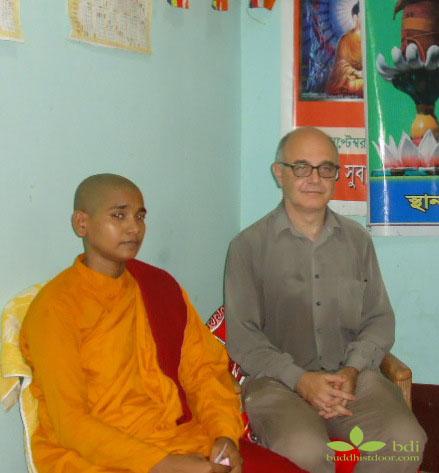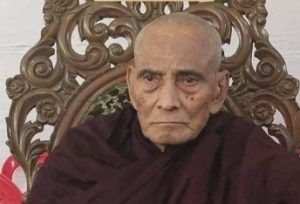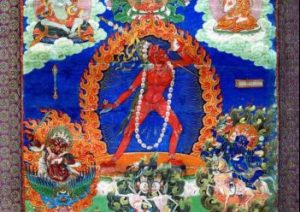In the second article in this series, I share my personal reflections on my journey to Bangladesh from 25 May–4 June. I have written this as a diary.
26–27 May
After an overnight bus ride from Dhaka we arrived in Chittagong very early in the morning. Imagine the sight of two venerables, one lay indigenous inhabitant of the Chittagong Hill Tracts (CHT), and one foreigner with their luggage, wandering around the early morning streets eager to find a restaurant and have breakfast! However, no matter where we looked, none were open so early. Finally, we came upon a restaurant in a hotel that was open for business, although it was way beyond our budget—nevertheless, the demands of the stomach overrode the concerns of the wallet!
After breakfast we made our way to the assistant police commissioner’s office to apply for a permit for me to enter the CHT. Following a slight delay, the process was thankfully quick and stress-free, and we went on our merry way with the permit (and some photocopies) firmly in my possession. Entry to the CHT now assured, I was relieved that there would be no need to rearrange my plans.
A lunch had been arranged at the residence of Venerable Gautami, one of the few ordained Theravadin nuns in Bangladesh. I was completely and pleasantly surprised by the hospitality we received and by the number of dishes that were endlessly placed on the table in front of us. Ven. Gautami and her devotees were always attentive and considerate.
During a short power outage, to which I would quickly become accustomed throughout my trip (thank goodness I am not a slave to Wifi or the internet!)—they can last from 15 minutes up to many hours—one young boy stood beside me with a contented smile, patiently waving a fan until the electricity was restored.
After lunch came a video interview with Ven. Gautami that had kindly been arranged for me by a Bangladeshi monk in Hong Kong. We discussed what led to her being ordained, the difficulties she has faced, her interaction with both the local community and the sangha, and her future plans. I also wanted to know about her hopes for female ordination within the Theravada tradition, which has still not received broad acceptance or recognition throughout South and Southeast Asia.
I was nervous during the taping because this was my first experience of a video interview, and I had not expected that a fair number of her supporters would be there as well, standing or sitting at the back of the room. It was also very hot and close because we had to turn off all the fans to ensure that our voices could be recorded clearly. [I discovered after returning to Hong Kong that a Bangladesh website, dhammainfo, had posted an article about our visit to Ven. Gautami one day later.]
After the interview our hired car took us to Rangamati district in the CHT, where I would stay for two nights at a temple in a small village just the other side of the border with the Chittagong Plains (for more on my stay here, see “Villagers Observing ‘Uposatha’ in Rangamati”). It had been raining before we arrived at the border post, and surprisingly there were no border guards—perhaps they wanted to escape the rain? I therefore did not have to produce my permit for inspection, and it was not until I arrived in Rangamati main town on 28 May that I needed to show it for the first time.
After paying my respects to the monks at the village temple, I quickly settled myself down in the room I had been allocated. Dinner was prepared by one of the villagers, my friend’s sister, and was both simple and delicious! The open-air shower later that evening brought back warm memories of my short time as a monk in southern Thailand.
***
28–29 May
Spending these two days at Moanoghar (for more on my visit to Moanoghar, see “Moanoghar, Beacon of Hope” and “Looking from the Inside Out”) has left an indelible mark on my memory of the trip to Bangladesh. Two things stand out in addition to my time at the school: Bana Vihar and the boat trip to Shuvalong Falls.
Bana Vihar is the monastery of one of Bangladesh’s most respected monks, Venerable Sadhanananda Mahathera, affectionately referred to as Bana Bhante. When he decided to remain in Rangamati, this vihara was built for him in 1974. It covers 33 acres of land surrounded on three sides by Kaptai Lake. In addition to the natural beauty of the grounds, two of the many sacred places stand out: the two Bodhi trees festooned with prayer flags and the Seven-storied Heaven House—the narrow, winding walkways leading up into the house represent how difficult it is to reach Heaven.
In the morning of 29 May Venerable Buddhadatta, the joint secretary of Moanoghar, had arranged a trip to Shuvalong Falls on Kaptai Lake. The man-made lake was formed after the completion of the Kaptai hydroelectric dam on Karnaphuli River in 1962. This new lake left 54,000 acres of land under water, about 40 per cent of the area’s total arable land, along with 29 square miles of government-owned forests and 240 square miles of other forest land.
The creation of the lake submerged the houses of 18,000 families, and 100,000 people were displaced. Hearing more about this from Ven. Buddhadatta, I looked over the placid lake and tried to envisage for myself the countless families forced into migration with little or no compensation and their homes now somewhere beneath me.
Rising above the banks of the lake I could see the dwellings of the recently arrived Muslim settlers, and wondered about the potential strife with the local indigenous community over valuable resources such as land. It was a leisurely and pleasant boat trip if you could forget the disquieting image of the displaced people’s homes bereft of life, lying beneath the water.
Spending time at Shuvalong Falls was a delight, all the more so as our group of five had it all to ourselves! We disembarked, removed our sandals, and made our way through the mud and soft undergrowth to the falls, where we dabbled our feet in the pool of water in front of the waterfall as well as in the water cascading down from above. As Ven. Buddhadatta and I scrambled up part of the rock face, I could hear and see the other venerables playfully enjoying themselves in the water, taking photos and laughing with a childlike innocence. Each one of us was “in the moment” and had simply “let go.”
***
As I prepared to leave Rangamati for Bandarban, higher up in the CHT, I reflected on what Monaoghar throughout its long history has done with very limited resources for the indigenous children from all over the Hill Tracts. I promised Ven. Buddhadatta I would sponsor a child and that I would leave the choice to his discretion based on the student’s situation and need.
* Note: The writer has been sponsoring a child since returning to Hong Kong.
For further information, see:











